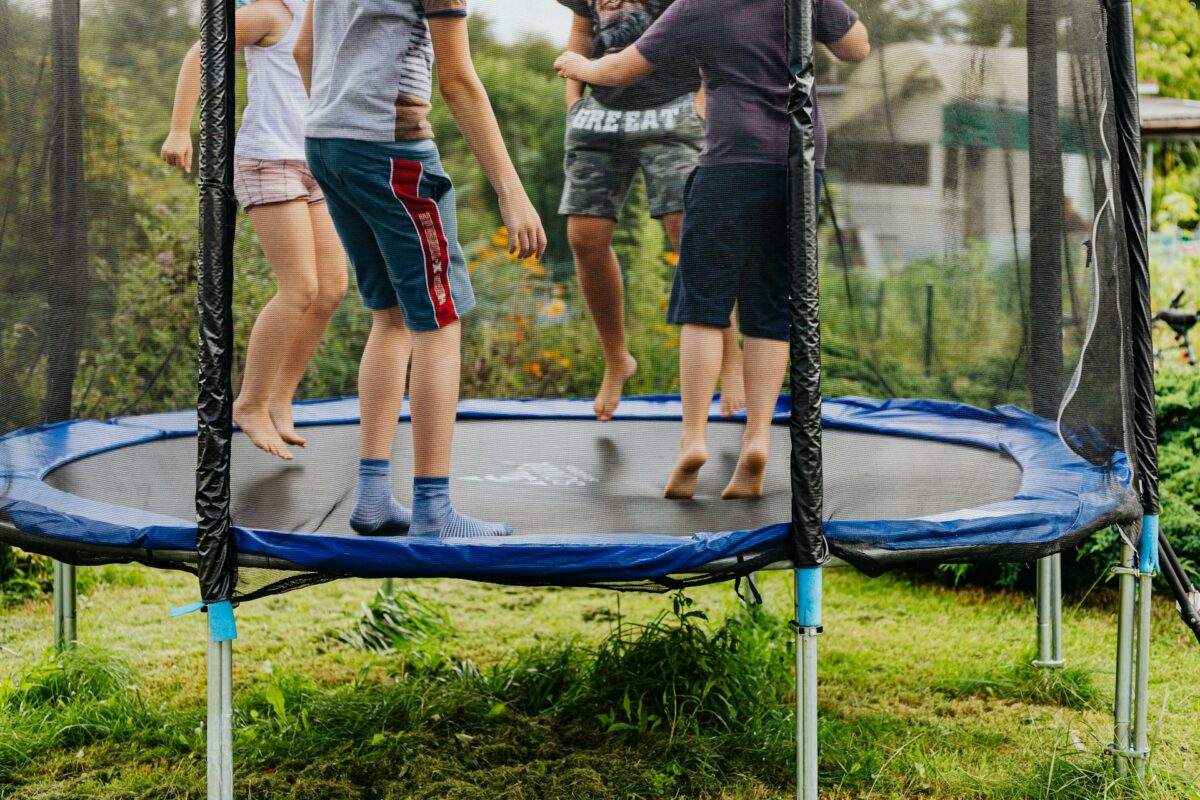Having a trampoline in your yard is great for family fun and offers tremendous health benefits, but moving a trampoline can be a challenge. Whether you’re repositioning it for better sun exposure or relocating it to a new home, doing it safely is crucial to prevent damage to the equipment and injury to yourself. Unlike other outdoor furniture, a trampoline can’t just be lifted and carried: Its size, weight, and awkward circular shape all present unique challenges.
As a result of homeowners being frustrated by these challenges, trampolines are one of the top five items that homeowners leave behind in a move, but with proper planning and techniques or professional help from full-service movers like Joey’s Movers, you can successfully bring your family’s favorite bouncing spot to your new home, without excessive hassle or expense. Below, we’ll show you the options for moving a trampoline of any size, whether you’re looking to move it yourself or considering professional assistance.
How to Easily Move a Trampoline Short Distances
Moving a trampoline from one spot to another on your property or to a neighboring location may not require you to fully disassemble your trampoline. Here are some practical approaches:
Using Trampoline Wheels
Despite their convenience, less than 20% of trampoline owners use trampoline wheels. These specialized accessories connect to the trampoline legs and allow you to roll the entire unit across flat surfaces. For short-distance moves, these wheels come at a minimal cost, can cut your moving time in half, and eliminate the need for extra help.
With trampoline wheels installed:
- Lift one side of the trampoline slightly
- Attach the wheeled brackets to the legs
- Roll the trampoline to its new location
- Once positioned, remove the wheels
Enlisting Help for Manual Carrying
For trampolines without wheels, gathering several strong adults is a common answer:
- Small trampolines (8-10 ft): 2-3 people
- Medium trampolines (12-14 ft): 4-5 people
- Large trampolines (15+ ft): 6+ people
Position your helpers evenly around the frame, lift simultaneously, and walk carefully to the new location. Clearing the path of obstacles beforehand and communicating clearly during the move are the keys to success and avoiding injuries.
Removing Safety Features First
Before attempting any trampoline move, always:
- Take down safety netting and poles
- Remove padding around the edge
- Secure or remove loose spring covers
This makes the trampoline lighter and prevents accessories from catching on objects during transport.
What to Avoid
Never drag a trampoline across the ground. Doing so risks:
- Bending or warping the frame
- Tearing the jump mat
- Damaging your lawn or paving
- Straining your back or shoulders
How to Move a Trampoline Without Taking It Apart
In some cases, complete disassembly seems excessive. There are ways to transport an intact trampoline, but it’s important to be aware of when it is and isn’t the right answer:
When the No-Disassembly Method Works
Moving a fully assembled trampoline is possible when:
- The trampoline is small to medium-sized (under 12 ft)
- The terrain is flat and obstacle-free
- The distance is relatively short
- You have adequate help available
- There are no narrow gates or passages that need to be navigated
Helpful Tools
Having the right equipment will make moving a fully assembled trampoline easier:
- Trampoline wheels
- Moving straps
- Furniture dollies
- Furniture sliders
Step-by-Step Intact Moving
- Clear the pathway completely
- Remove safety netting, padding, and accessories
- Attach wheels or lifting devices if available
- Lift simultaneously using proper techniques to avoid back injuries
- Move slowly, keeping the frame level
- Set the trampoline down gently to avoid bending its legs
Risks to Consider
Movers report that transporting trampolines without disassembly increases the risk of damaging the frame by over 60%. The most common damages include:
- Bent frame sections that no longer distribute weight evenly
- Stretched or torn jump mats from improper lifting
- Broken or deformed leg joints
- Misaligned springs that cause uneven tension
Before trying to do it on your own, consider the time and money saved against the cost of potential damage and replacing the entire trampoline.
How to Move a Trampoline on a Truck
Transporting a trampoline using a pickup truck or trailer requires careful preparation and securing techniques.
Size Considerations
First, check to see if your trampoline will fit:
- Measure the trampoline’s diameter and the truck bed or trailer dimensions
- For standard pickup trucks, trampolines larger than 12 ft will generally require partial disassembly
- Remember that the trampoline must be secured and can’t have excessive overhang
Partial Disassembly Method
Joey’s Movers has found that most successful trampoline moves use a hybrid approach where certain components are removed but the main structure is left intact. This involves:
- Removing the safety netting, poles, and padding
- Detaching the legs from the frame
- Keeping the springs and jump mat connected to the frame
- Transporting the circular frame as one piece
Doing it this way reduces the bulk while minimizing reassembly time.
Securing for Transport
To prevent wind damage and shifting, proper securing is critical:
- Put moving blankets or cardboard underneath the frame to prevent scratching
- Use at least four ratchet straps to secure the frame to the truck bed
- For maximum stability, run straps both over and through the frame
- Cover with tarps if traveling long distances or in inclement weather
- Drive at moderate speeds, especially on highways
Loading Techniques
How to move a trampoline on a truck:
- Have at least 3-4 people available to lift the trampoline
- Position it frame-side down in the truck bed
- If possible, center the weight over the axles
- Make sure no parts extend beyond legal overhang limits
How to Disassemble a Trampoline for Transport
For long-distance moves or when limited space makes intact transport impossible, complete disassembly is the safest way to go. Trampoline disassembly and reassembly takes about 1.5 to 2 hours, so add that to the time you’re estimating it will take to move it yourself.
Complete Disassembly Steps
- Remove the safety enclosure:
- Detach netting from poles
- Unscrew and remove enclosure poles
- Store netting in a protective bag
- Remove padding and spring cover:
- Untie or unclip the padding
- Fold and store in a clean, dry container
- Detach springs:
- Use a spring tool (or pliers with a cloth to prevent slipping)
- Work in an alternating pattern (remove one, then the opposite side)
- Continue until all springs are removed
- Store springs in a sealed container to prevent rust
- Remove the jump mat:
- Once all springs are detached, lift the mat from the frame
- Fold carefully to avoid creases
- Store in a clean, dry bag
- Disassemble the frame:
- Remove legs from the frame sections
- Separate frame sections at connection points
- Group similar parts together
- Organize hardware:
- Keep all bolts, nuts, and small parts in labeled bags
- Take photos before disassembly to help with reassembly
Tools Required
For most trampolines, you’ll need:
- Spring pull tool
- Socket wrench or adjustable wrench
- Screwdriver (Phillips and flathead)
- Mallet (for separating stuck joints)
- Work gloves
- Storage bags and containers
- Marker and tape for labeling
Are Trampolines Easy to Dismantle?
The difficulty of dismantling a trampoline varies by model and construction type:
- Spring-Based Trampolines: Traditional spring trampolines take longer to disassemble because of the number of springs that have to be removed. The process isn’t complicated but can be time-consuming and physically demanding.
- Springless Trampolines: Modern springless designs have fewer components and simpler connection methods that make them easier to take apart, but their specialized parts may require more care during transport.
Time Investment
For a standard 12-foot round trampoline, figure on:
- Safety enclosure removal: 15-20 minutes
- Spring and mat removal: 30-40 minutes
- Frame disassembly: 15-30 minutes
- Total time with two adults: 60-90 minutes
Having a second person significantly reduces the time needed and prevents potential injuries from uneven tension release or heavy lifting.
How to Move a Trampoline by Yourself
While moving a trampoline is ideally a team effort, with proper planning it’s possible to relocate smaller models by yourself.
Solo Moving Guidelines
For small trampolines (8 ft or smaller):
- Prepare the equipment:
- Remove all accessories and safety features
- Consider partial disassembly (removing legs while keeping the frame, mat, and springs intact)
- Use mechanical assistance:
- Place furniture sliders under each leg
- Use a furniture dolly under one section to pivot and roll
- Consider temporary DIY wheel attachments
- Move in stages:
- Lift one section at a time, shifting the trampoline in small increments
- Take frequent breaks to avoid strain
- Work on flat, smooth surfaces when possible
Methods to Avoid
When moving alone, never:
- Drag the trampoline across rough surfaces
- Attempt to load it into a vehicle without help
- Risk personal injury by lifting excessive weight
- Flip or roll the trampoline on its edge (this damages the frame)
Disassembling Solo
If disassembling alone:
- Work in sections, completing one area before moving to the next
- Follow a “star pattern” for spring removal to maintain balance
- Lay out all parts in an organized manner as you disassemble
- Take frequent breaks to avoid fatigue-related mistakes
When to Let Movers Handle It
Sometimes, professional assistance is the smartest, most practical solution for moving a trampoline. Consider hiring experts when:
Size and Complexity Concerns
- Your trampoline exceeds 14 feet in diameter
- Your trampoline has complex features like basketball hoops or unique shapes
- You have physical limitations that make lifting unsafe
- The move involves navigating difficult terrain or obstacles
Long-Distance Relocation
For moves beyond a local area:
- Professional movers ensure proper disassembly and packing
- Appropriate transport vehicles prevent exposure damage
- Expert handling reduces the risk of lost parts
- Reassembly service saves significant time at your new home
Professional Moving Benefits
Joey’s Movers specializes in challenging items like trampolines, offering:
- Proper tools and equipment for efficient disassembly
- Experienced teams that understand trampoline mechanics
- Appropriate packing materials for frame protection
- Insurance coverage for transport damage
- Expert reassembly at your destination
Visit our specialty items moving services for more information on how we can assist with your trampoline relocation.
FAQs
How to easily move a trampoline?
For the easiest short-distance moves, use trampoline wheels and roll the unit to its new location. Remove safety netting and padding first, and ensure the path is clear of obstacles. For longer distances, remove the legs while keeping the frame intact.
How to disassemble a trampoline for transport?
Start by removing the safety enclosure and padding. Then, using a spring tool, remove all springs in an alternating pattern. Once the springs are removed, take off the jumping mat, then disassemble the frame by disconnecting the legs and separating frame sections. Store all hardware in labeled bags and take photos to help with reassembly.
Are trampolines easy to dismantle?
Trampolines can be dismantled by most homeowners with basic tools, though the process takes 60-90 minutes for a standard-sized unit. Spring-based models take longer than springless designs. The bigger and older the trampoline, the harder it is to do.
Joey’s Movers Will Have You Bouncing Again in No Time
Knowing how to move a small-to-medium-sized trampoline can save you time, prevent equipment damage, and avoid personal injury, but if your trampoline is large, your move is complicated, or you want the assurance of professional handling, Joey’s Movers is ready to assist. Our experienced teams handle trampolines and other challenging outdoor items with expertise and care.
Contact Joey’s Movers for expert assistance with your trampoline relocation. Call us today at (847) 674-7779 or get a free online quote to ensure your family’s favorite bouncing spot arrives safely at your new home.
Photo by Kaboompics.com



